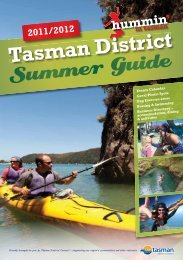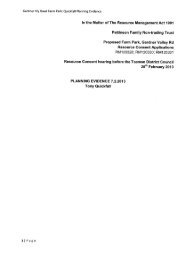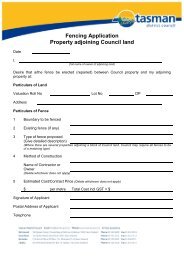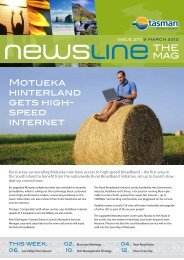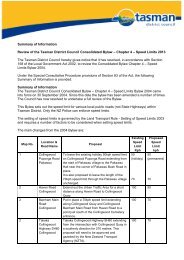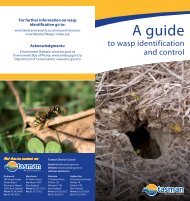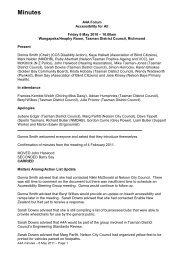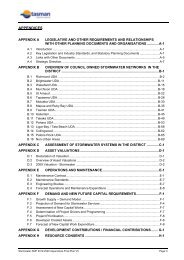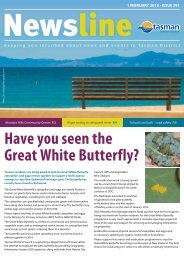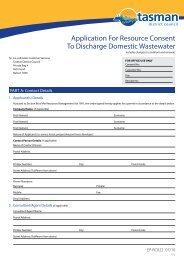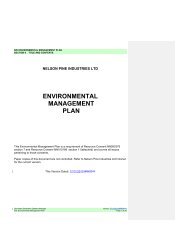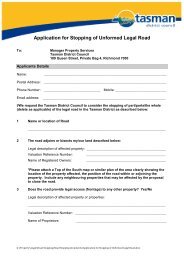Abel Tasman Foreshore Scenic Reserve Draft Management Plan
Abel Tasman Foreshore Scenic Reserve Draft Management Plan
Abel Tasman Foreshore Scenic Reserve Draft Management Plan
You also want an ePaper? Increase the reach of your titles
YUMPU automatically turns print PDFs into web optimized ePapers that Google loves.
4.1.2 European history<br />
In 1841, the Astrolabe Roadstead/Whenuakura/Te Karetu was the initial anchorage<br />
of the three New Zealand Company ships seeking a suitable site for the Nelson<br />
settlement. However, it was the early to mid 1850s before land was purchased by<br />
European settlers on the <strong>Abel</strong> <strong>Tasman</strong> coast.<br />
The early European settlers felled the lowland forests for timber and cleared the land<br />
for farming in several bays, particularly along the northern parts of the coast around<br />
Totaranui, Awaroa, Whariwharangi and Wainui. They relied on coastal shipping for<br />
communication and supplies, with goods, stock and passengers being ferried ashore<br />
in small boats and lighters. Wharves weren’t usually built due to the exposed nature<br />
of the shorelines.<br />
Other industries included shipbuilding (at Awaroa and Torrent Bay/Rakauroa), barkstripping<br />
for tanning (at Bark Bay/Wairinga) and quarrying at Tonga Bay. The<br />
Cawthron steps in front of Nelson Cathedral and the Wellington Post Office were<br />
built using granite blocks from Tonga Quarry. Several small settlements were<br />
established, including Torrent Bay/Rakauroa and Awaroa. These settlements remain<br />
today as privately-owned land adjoined by <strong>Abel</strong> <strong>Tasman</strong> National Park and the<br />
reserve.<br />
There are also the remains of the historic ship, the Venture, in the eastern arm of the<br />
Awaroa Inlet, near the mouth of Venture Creek. This wooden ketch was the last of the<br />
vessels built by William Hadfield at Awaroa from local kahikatea, rata and beech. She<br />
was launched in 1906 and used for local shipping for many years before being left to<br />
rot in the inlet. Parts of the hull can still be seen at low tide. Piles of rock ballast that<br />
was discharged from loading scows are also visible at low tide in Awaroa Inlet.<br />
4.1.3 Recent history<br />
From the 1920s the <strong>Abel</strong> <strong>Tasman</strong> coast became popular with holidaymakers who<br />
gradually established baches in many of the sandy bays. Later, some of these<br />
occupied areas became part of the national park. From as early as the 1890s people<br />
considered protecting the <strong>Abel</strong> <strong>Tasman</strong> coast. The first firm proposals were made in<br />
the 1930’s. In 1936, Perrine Moncrieff set aside her property near the Astrolabe<br />
Roadstead/Whenuakura/Te Karetu as a private reserve and began a concerted<br />
campaign to set aside the whole area as a national park. The tercentenary of <strong>Abel</strong><br />
<strong>Tasman</strong>'s 1642 visit provided the final impetus to her efforts and the <strong>Abel</strong> <strong>Tasman</strong><br />
National Park was created in 1942, as a permanent memorial to his visit. Sixty-five<br />
years later, the adjacent foreshore became a scenic reserve in 2007.<br />
4.2 <strong>Management</strong> of historical and cultural heritage<br />
4.2.1 Protection of historic places<br />
Sections 3(1)(a)(v) and 19(2)(d) of the <strong>Reserve</strong>s Act 1977 seek to preserve and<br />
manage historic, cultural and archaeological features or values on the reserve.<br />
Section 94(1)(m) makes it an offence to damage the historic features in the reserve,<br />
without written authorisation from the Administration Committee.<br />
In accordance with the Historic Places Act 1993, the Administration Committee<br />
wishes to prevent the accidental destruction of any historic place, including<br />
archaeological sites, and will obtain an authority from the New Zealand Historic<br />
4. Historical and cultural heritage 33



